Assessing Talent Management Strategies in Retail: A Project Report
VerifiedAdded on 2022/11/24
|20
|4510
|152
Report
AI Summary
This project report assesses talent management strategies within the retail industry, using Marks & Spencer as a case study. The report begins with an introduction to talent management and its importance, followed by the project's aims, objectives, and research questions. Task 1 outlines the project management plan, including time, cost, quality, scope, risk, and resources. A work breakdown structure and Gantt chart are also presented. Task 2 details the research methodology, including primary and secondary data collection methods, and the use of questionnaires. Task 3 analyzes the collected data, presenting findings on talent management concepts, practices, and benefits, along with recommendations. Task 4 provides a reflection on the project. The report concludes with a summary of the findings and a list of references, including an appendix with a project log-book and performance review template.
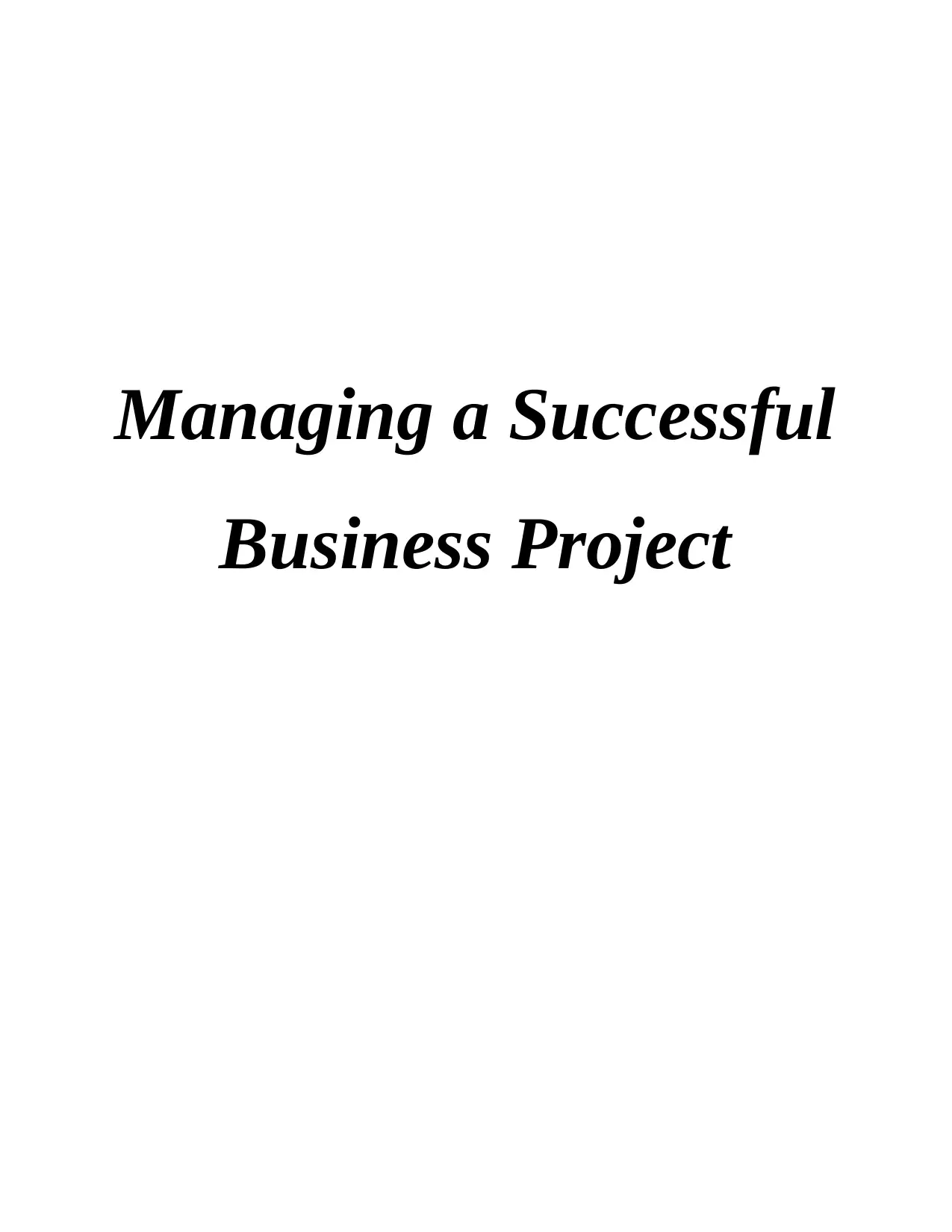
Managing a Successful
Business Project
Business Project
Paraphrase This Document
Need a fresh take? Get an instant paraphrase of this document with our AI Paraphraser
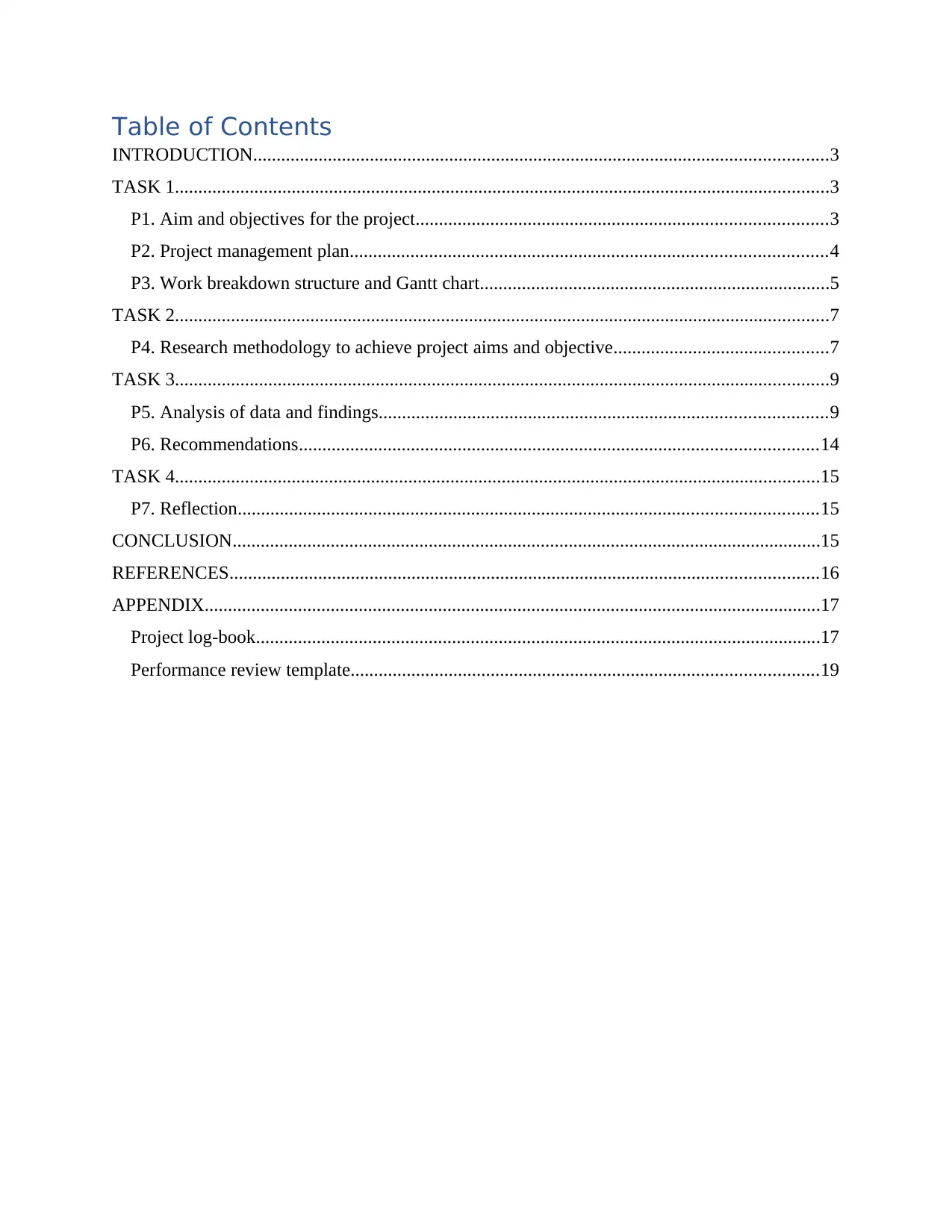
Table of Contents
INTRODUCTION...........................................................................................................................3
TASK 1............................................................................................................................................3
P1. Aim and objectives for the project........................................................................................3
P2. Project management plan......................................................................................................4
P3. Work breakdown structure and Gantt chart...........................................................................5
TASK 2............................................................................................................................................7
P4. Research methodology to achieve project aims and objective..............................................7
TASK 3............................................................................................................................................9
P5. Analysis of data and findings................................................................................................9
P6. Recommendations...............................................................................................................14
TASK 4..........................................................................................................................................15
P7. Reflection............................................................................................................................15
CONCLUSION..............................................................................................................................15
REFERENCES..............................................................................................................................16
APPENDIX....................................................................................................................................17
Project log-book.........................................................................................................................17
Performance review template....................................................................................................19
INTRODUCTION...........................................................................................................................3
TASK 1............................................................................................................................................3
P1. Aim and objectives for the project........................................................................................3
P2. Project management plan......................................................................................................4
P3. Work breakdown structure and Gantt chart...........................................................................5
TASK 2............................................................................................................................................7
P4. Research methodology to achieve project aims and objective..............................................7
TASK 3............................................................................................................................................9
P5. Analysis of data and findings................................................................................................9
P6. Recommendations...............................................................................................................14
TASK 4..........................................................................................................................................15
P7. Reflection............................................................................................................................15
CONCLUSION..............................................................................................................................15
REFERENCES..............................................................................................................................16
APPENDIX....................................................................................................................................17
Project log-book.........................................................................................................................17
Performance review template....................................................................................................19
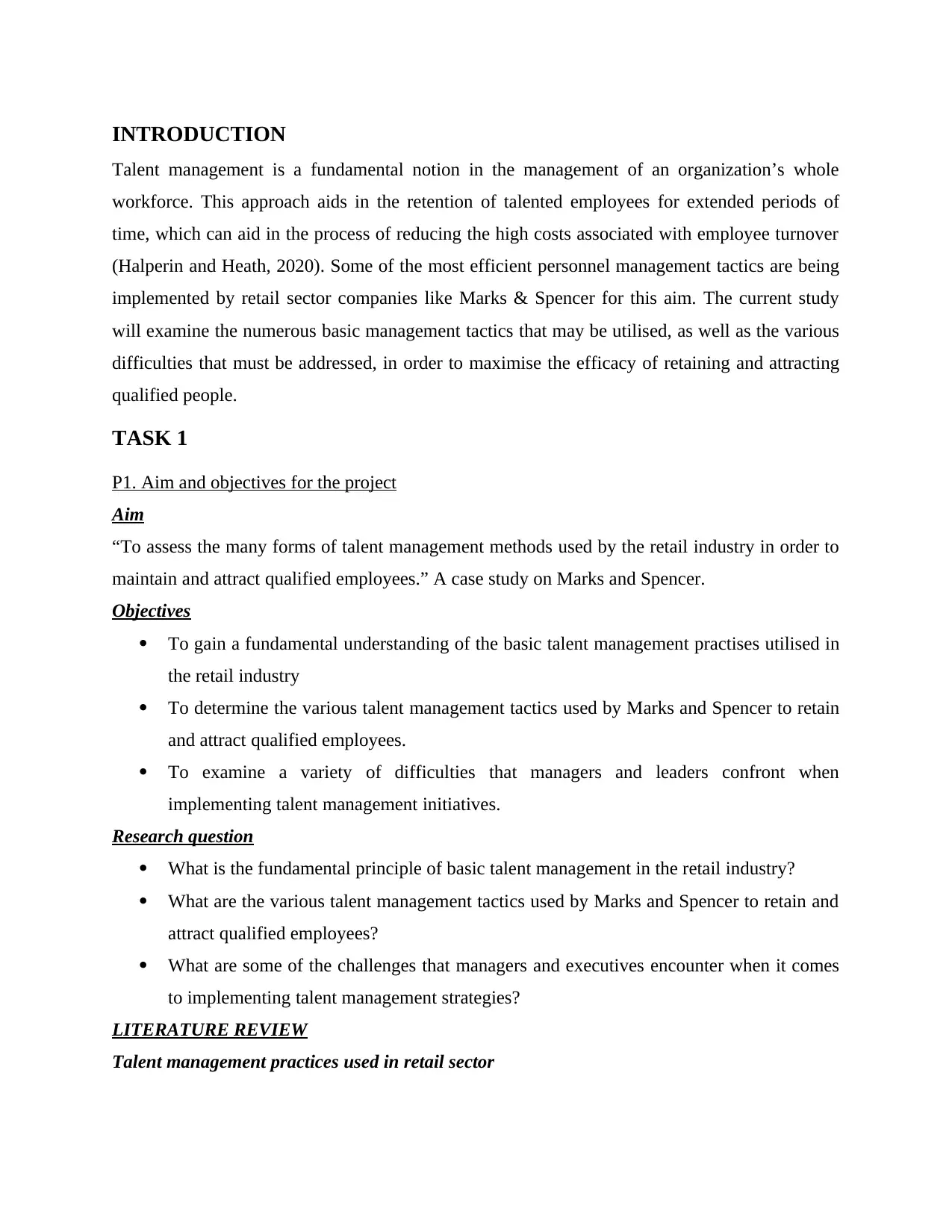
INTRODUCTION
Talent management is a fundamental notion in the management of an organization’s whole
workforce. This approach aids in the retention of talented employees for extended periods of
time, which can aid in the process of reducing the high costs associated with employee turnover
(Halperin and Heath, 2020). Some of the most efficient personnel management tactics are being
implemented by retail sector companies like Marks & Spencer for this aim. The current study
will examine the numerous basic management tactics that may be utilised, as well as the various
difficulties that must be addressed, in order to maximise the efficacy of retaining and attracting
qualified people.
TASK 1
P1. Aim and objectives for the project
Aim
“To assess the many forms of talent management methods used by the retail industry in order to
maintain and attract qualified employees.” A case study on Marks and Spencer.
Objectives
To gain a fundamental understanding of the basic talent management practises utilised in
the retail industry
To determine the various talent management tactics used by Marks and Spencer to retain
and attract qualified employees.
To examine a variety of difficulties that managers and leaders confront when
implementing talent management initiatives.
Research question
What is the fundamental principle of basic talent management in the retail industry?
What are the various talent management tactics used by Marks and Spencer to retain and
attract qualified employees?
What are some of the challenges that managers and executives encounter when it comes
to implementing talent management strategies?
LITERATURE REVIEW
Talent management practices used in retail sector
Talent management is a fundamental notion in the management of an organization’s whole
workforce. This approach aids in the retention of talented employees for extended periods of
time, which can aid in the process of reducing the high costs associated with employee turnover
(Halperin and Heath, 2020). Some of the most efficient personnel management tactics are being
implemented by retail sector companies like Marks & Spencer for this aim. The current study
will examine the numerous basic management tactics that may be utilised, as well as the various
difficulties that must be addressed, in order to maximise the efficacy of retaining and attracting
qualified people.
TASK 1
P1. Aim and objectives for the project
Aim
“To assess the many forms of talent management methods used by the retail industry in order to
maintain and attract qualified employees.” A case study on Marks and Spencer.
Objectives
To gain a fundamental understanding of the basic talent management practises utilised in
the retail industry
To determine the various talent management tactics used by Marks and Spencer to retain
and attract qualified employees.
To examine a variety of difficulties that managers and leaders confront when
implementing talent management initiatives.
Research question
What is the fundamental principle of basic talent management in the retail industry?
What are the various talent management tactics used by Marks and Spencer to retain and
attract qualified employees?
What are some of the challenges that managers and executives encounter when it comes
to implementing talent management strategies?
LITERATURE REVIEW
Talent management practices used in retail sector
⊘ This is a preview!⊘
Do you want full access?
Subscribe today to unlock all pages.

Trusted by 1+ million students worldwide
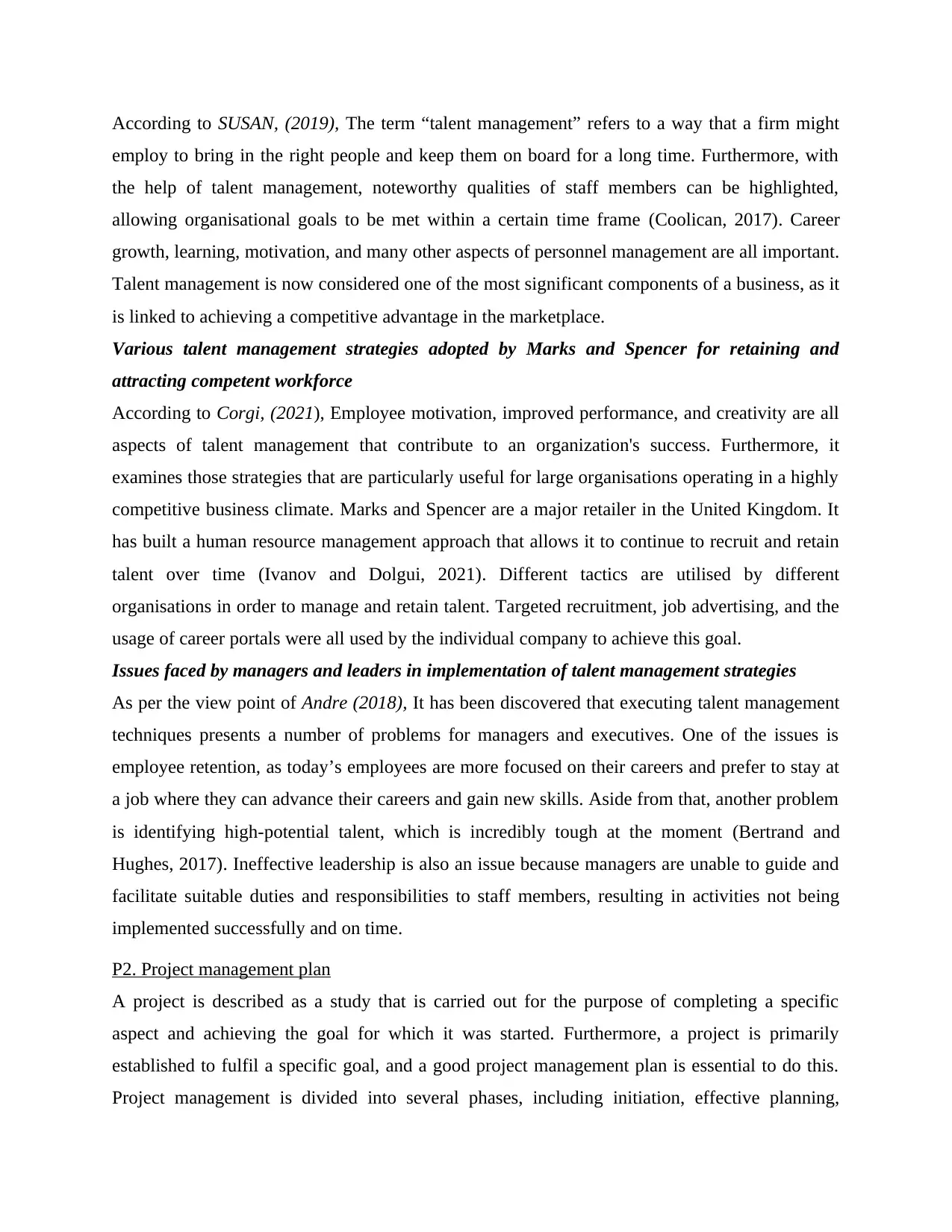
According to SUSAN, (2019), The term “talent management” refers to a way that a firm might
employ to bring in the right people and keep them on board for a long time. Furthermore, with
the help of talent management, noteworthy qualities of staff members can be highlighted,
allowing organisational goals to be met within a certain time frame (Coolican, 2017). Career
growth, learning, motivation, and many other aspects of personnel management are all important.
Talent management is now considered one of the most significant components of a business, as it
is linked to achieving a competitive advantage in the marketplace.
Various talent management strategies adopted by Marks and Spencer for retaining and
attracting competent workforce
According to Corgi, (2021), Employee motivation, improved performance, and creativity are all
aspects of talent management that contribute to an organization's success. Furthermore, it
examines those strategies that are particularly useful for large organisations operating in a highly
competitive business climate. Marks and Spencer are a major retailer in the United Kingdom. It
has built a human resource management approach that allows it to continue to recruit and retain
talent over time (Ivanov and Dolgui, 2021). Different tactics are utilised by different
organisations in order to manage and retain talent. Targeted recruitment, job advertising, and the
usage of career portals were all used by the individual company to achieve this goal.
Issues faced by managers and leaders in implementation of talent management strategies
As per the view point of Andre (2018), It has been discovered that executing talent management
techniques presents a number of problems for managers and executives. One of the issues is
employee retention, as today’s employees are more focused on their careers and prefer to stay at
a job where they can advance their careers and gain new skills. Aside from that, another problem
is identifying high-potential talent, which is incredibly tough at the moment (Bertrand and
Hughes, 2017). Ineffective leadership is also an issue because managers are unable to guide and
facilitate suitable duties and responsibilities to staff members, resulting in activities not being
implemented successfully and on time.
P2. Project management plan
A project is described as a study that is carried out for the purpose of completing a specific
aspect and achieving the goal for which it was started. Furthermore, a project is primarily
established to fulfil a specific goal, and a good project management plan is essential to do this.
Project management is divided into several phases, including initiation, effective planning,
employ to bring in the right people and keep them on board for a long time. Furthermore, with
the help of talent management, noteworthy qualities of staff members can be highlighted,
allowing organisational goals to be met within a certain time frame (Coolican, 2017). Career
growth, learning, motivation, and many other aspects of personnel management are all important.
Talent management is now considered one of the most significant components of a business, as it
is linked to achieving a competitive advantage in the marketplace.
Various talent management strategies adopted by Marks and Spencer for retaining and
attracting competent workforce
According to Corgi, (2021), Employee motivation, improved performance, and creativity are all
aspects of talent management that contribute to an organization's success. Furthermore, it
examines those strategies that are particularly useful for large organisations operating in a highly
competitive business climate. Marks and Spencer are a major retailer in the United Kingdom. It
has built a human resource management approach that allows it to continue to recruit and retain
talent over time (Ivanov and Dolgui, 2021). Different tactics are utilised by different
organisations in order to manage and retain talent. Targeted recruitment, job advertising, and the
usage of career portals were all used by the individual company to achieve this goal.
Issues faced by managers and leaders in implementation of talent management strategies
As per the view point of Andre (2018), It has been discovered that executing talent management
techniques presents a number of problems for managers and executives. One of the issues is
employee retention, as today’s employees are more focused on their careers and prefer to stay at
a job where they can advance their careers and gain new skills. Aside from that, another problem
is identifying high-potential talent, which is incredibly tough at the moment (Bertrand and
Hughes, 2017). Ineffective leadership is also an issue because managers are unable to guide and
facilitate suitable duties and responsibilities to staff members, resulting in activities not being
implemented successfully and on time.
P2. Project management plan
A project is described as a study that is carried out for the purpose of completing a specific
aspect and achieving the goal for which it was started. Furthermore, a project is primarily
established to fulfil a specific goal, and a good project management plan is essential to do this.
Project management is divided into several phases, including initiation, effective planning,
Paraphrase This Document
Need a fresh take? Get an instant paraphrase of this document with our AI Paraphraser
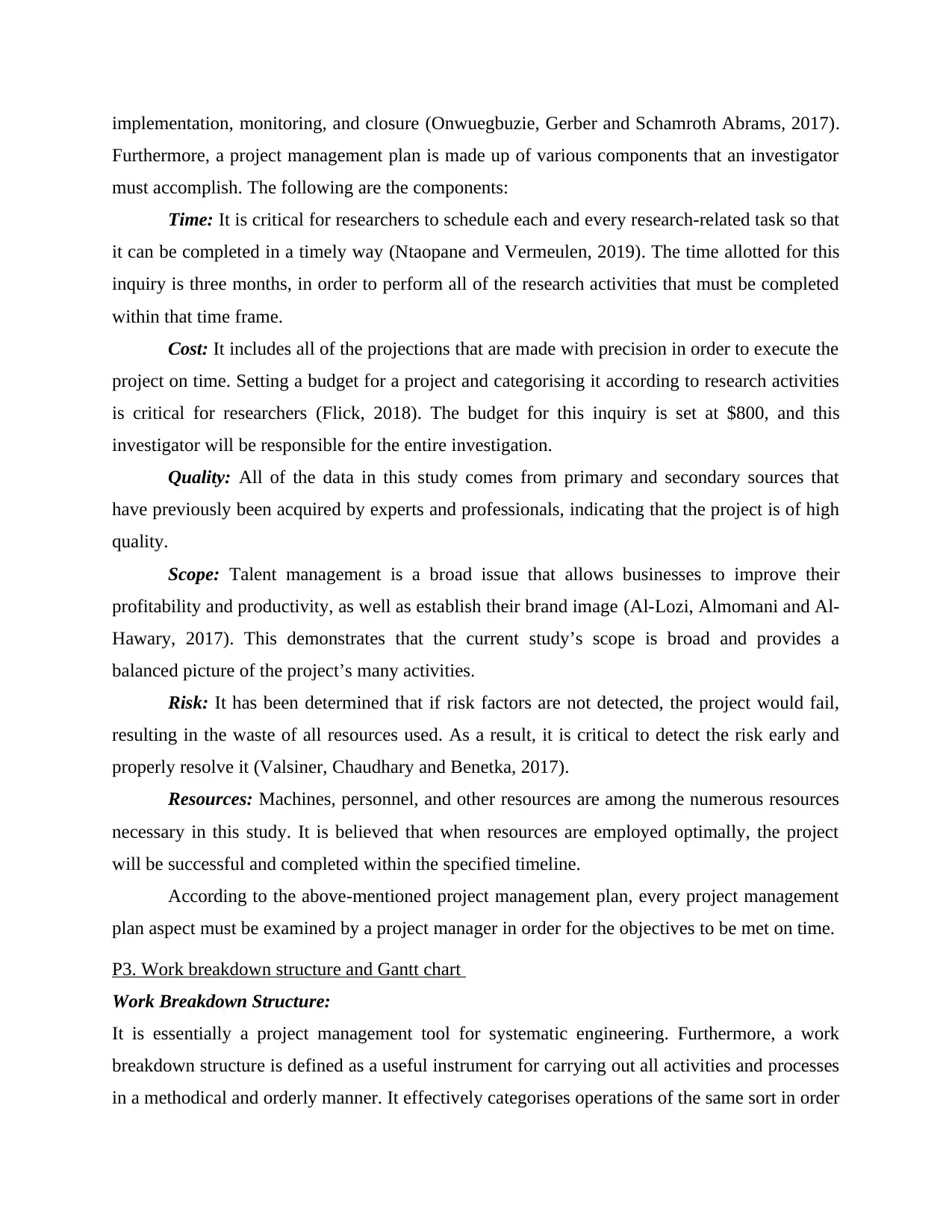
implementation, monitoring, and closure (Onwuegbuzie, Gerber and Schamroth Abrams, 2017).
Furthermore, a project management plan is made up of various components that an investigator
must accomplish. The following are the components:
Time: It is critical for researchers to schedule each and every research-related task so that
it can be completed in a timely way (Ntaopane and Vermeulen, 2019). The time allotted for this
inquiry is three months, in order to perform all of the research activities that must be completed
within that time frame.
Cost: It includes all of the projections that are made with precision in order to execute the
project on time. Setting a budget for a project and categorising it according to research activities
is critical for researchers (Flick, 2018). The budget for this inquiry is set at $800, and this
investigator will be responsible for the entire investigation.
Quality: All of the data in this study comes from primary and secondary sources that
have previously been acquired by experts and professionals, indicating that the project is of high
quality.
Scope: Talent management is a broad issue that allows businesses to improve their
profitability and productivity, as well as establish their brand image (Al-Lozi, Almomani and Al-
Hawary, 2017). This demonstrates that the current study’s scope is broad and provides a
balanced picture of the project’s many activities.
Risk: It has been determined that if risk factors are not detected, the project would fail,
resulting in the waste of all resources used. As a result, it is critical to detect the risk early and
properly resolve it (Valsiner, Chaudhary and Benetka, 2017).
Resources: Machines, personnel, and other resources are among the numerous resources
necessary in this study. It is believed that when resources are employed optimally, the project
will be successful and completed within the specified timeline.
According to the above-mentioned project management plan, every project management
plan aspect must be examined by a project manager in order for the objectives to be met on time.
P3. Work breakdown structure and Gantt chart
Work Breakdown Structure:
It is essentially a project management tool for systematic engineering. Furthermore, a work
breakdown structure is defined as a useful instrument for carrying out all activities and processes
in a methodical and orderly manner. It effectively categorises operations of the same sort in order
Furthermore, a project management plan is made up of various components that an investigator
must accomplish. The following are the components:
Time: It is critical for researchers to schedule each and every research-related task so that
it can be completed in a timely way (Ntaopane and Vermeulen, 2019). The time allotted for this
inquiry is three months, in order to perform all of the research activities that must be completed
within that time frame.
Cost: It includes all of the projections that are made with precision in order to execute the
project on time. Setting a budget for a project and categorising it according to research activities
is critical for researchers (Flick, 2018). The budget for this inquiry is set at $800, and this
investigator will be responsible for the entire investigation.
Quality: All of the data in this study comes from primary and secondary sources that
have previously been acquired by experts and professionals, indicating that the project is of high
quality.
Scope: Talent management is a broad issue that allows businesses to improve their
profitability and productivity, as well as establish their brand image (Al-Lozi, Almomani and Al-
Hawary, 2017). This demonstrates that the current study’s scope is broad and provides a
balanced picture of the project’s many activities.
Risk: It has been determined that if risk factors are not detected, the project would fail,
resulting in the waste of all resources used. As a result, it is critical to detect the risk early and
properly resolve it (Valsiner, Chaudhary and Benetka, 2017).
Resources: Machines, personnel, and other resources are among the numerous resources
necessary in this study. It is believed that when resources are employed optimally, the project
will be successful and completed within the specified timeline.
According to the above-mentioned project management plan, every project management
plan aspect must be examined by a project manager in order for the objectives to be met on time.
P3. Work breakdown structure and Gantt chart
Work Breakdown Structure:
It is essentially a project management tool for systematic engineering. Furthermore, a work
breakdown structure is defined as a useful instrument for carrying out all activities and processes
in a methodical and orderly manner. It effectively categorises operations of the same sort in order
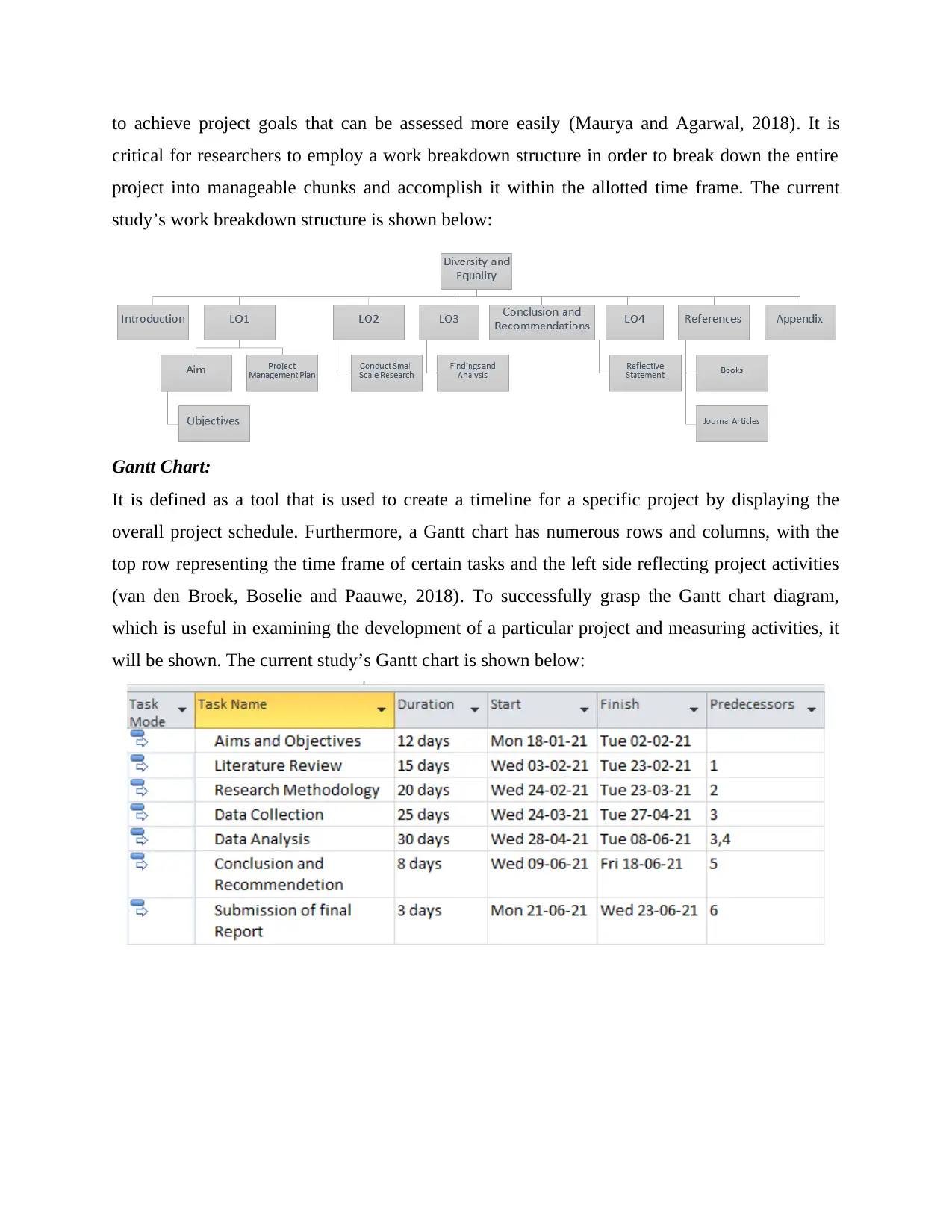
to achieve project goals that can be assessed more easily (Maurya and Agarwal, 2018). It is
critical for researchers to employ a work breakdown structure in order to break down the entire
project into manageable chunks and accomplish it within the allotted time frame. The current
study’s work breakdown structure is shown below:
Gantt Chart:
It is defined as a tool that is used to create a timeline for a specific project by displaying the
overall project schedule. Furthermore, a Gantt chart has numerous rows and columns, with the
top row representing the time frame of certain tasks and the left side reflecting project activities
(van den Broek, Boselie and Paauwe, 2018). To successfully grasp the Gantt chart diagram,
which is useful in examining the development of a particular project and measuring activities, it
will be shown. The current study’s Gantt chart is shown below:
critical for researchers to employ a work breakdown structure in order to break down the entire
project into manageable chunks and accomplish it within the allotted time frame. The current
study’s work breakdown structure is shown below:
Gantt Chart:
It is defined as a tool that is used to create a timeline for a specific project by displaying the
overall project schedule. Furthermore, a Gantt chart has numerous rows and columns, with the
top row representing the time frame of certain tasks and the left side reflecting project activities
(van den Broek, Boselie and Paauwe, 2018). To successfully grasp the Gantt chart diagram,
which is useful in examining the development of a particular project and measuring activities, it
will be shown. The current study’s Gantt chart is shown below:
⊘ This is a preview!⊘
Do you want full access?
Subscribe today to unlock all pages.

Trusted by 1+ million students worldwide
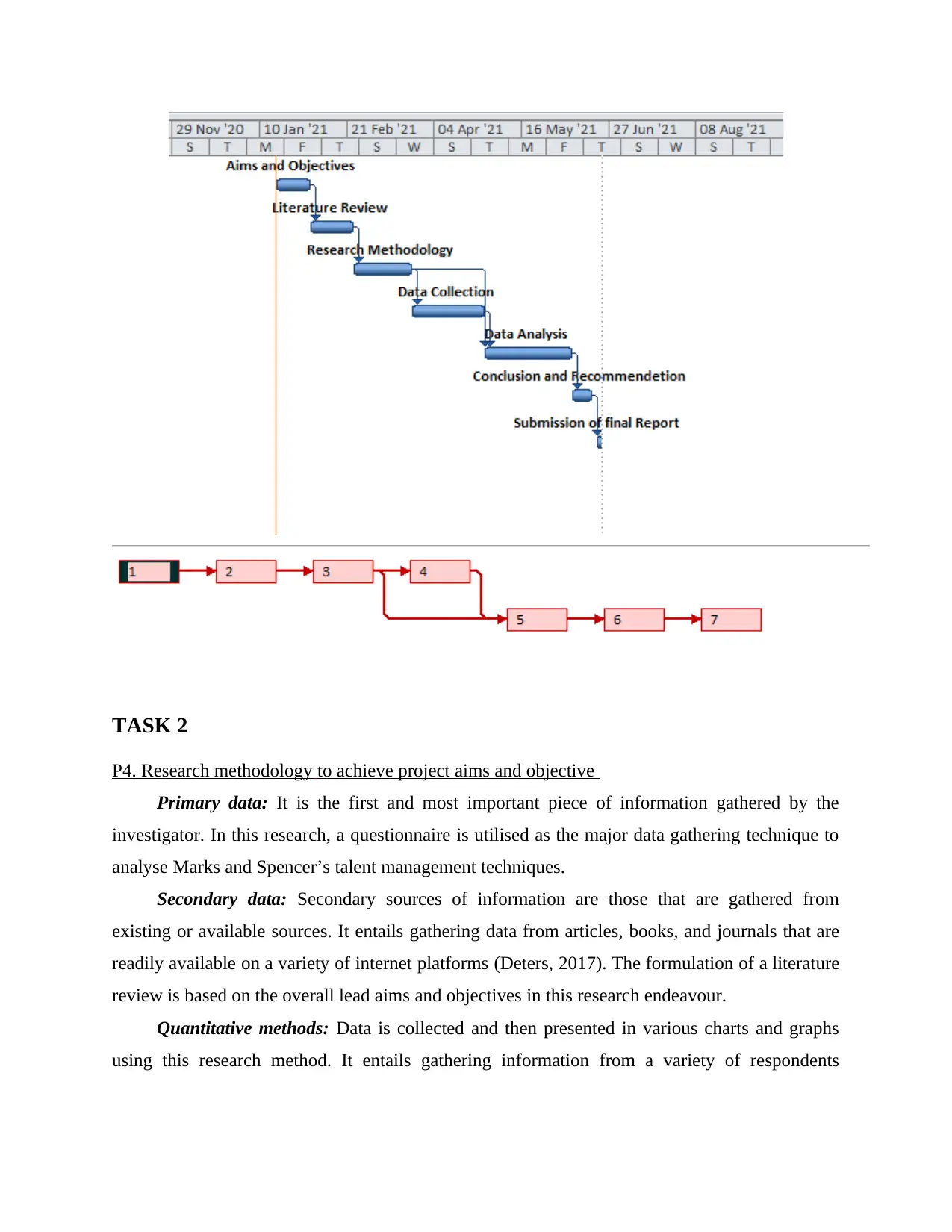
TASK 2
P4. Research methodology to achieve project aims and objective
Primary data: It is the first and most important piece of information gathered by the
investigator. In this research, a questionnaire is utilised as the major data gathering technique to
analyse Marks and Spencer’s talent management techniques.
Secondary data: Secondary sources of information are those that are gathered from
existing or available sources. It entails gathering data from articles, books, and journals that are
readily available on a variety of internet platforms (Deters, 2017). The formulation of a literature
review is based on the overall lead aims and objectives in this research endeavour.
Quantitative methods: Data is collected and then presented in various charts and graphs
using this research method. It entails gathering information from a variety of respondents
P4. Research methodology to achieve project aims and objective
Primary data: It is the first and most important piece of information gathered by the
investigator. In this research, a questionnaire is utilised as the major data gathering technique to
analyse Marks and Spencer’s talent management techniques.
Secondary data: Secondary sources of information are those that are gathered from
existing or available sources. It entails gathering data from articles, books, and journals that are
readily available on a variety of internet platforms (Deters, 2017). The formulation of a literature
review is based on the overall lead aims and objectives in this research endeavour.
Quantitative methods: Data is collected and then presented in various charts and graphs
using this research method. It entails gathering information from a variety of respondents
Paraphrase This Document
Need a fresh take? Get an instant paraphrase of this document with our AI Paraphraser
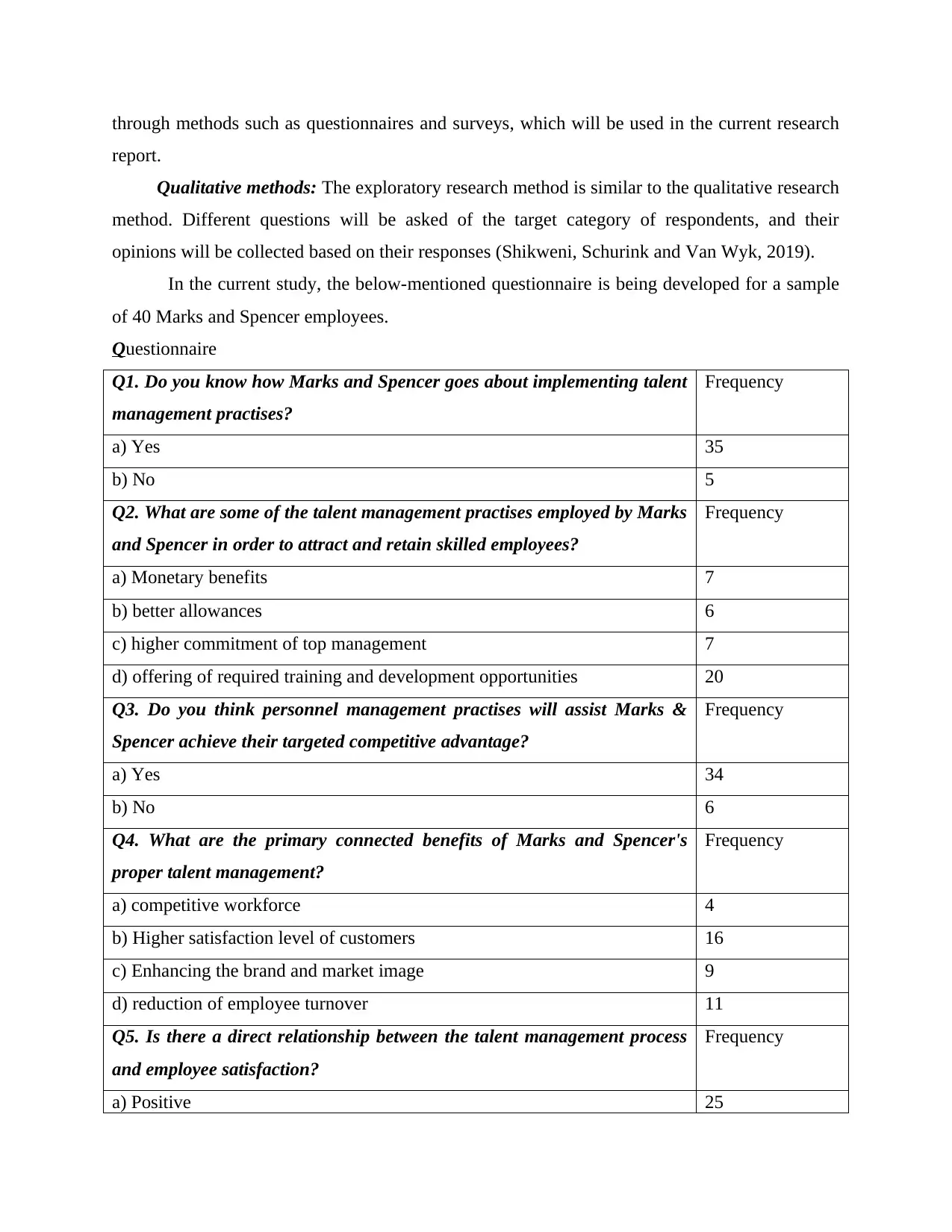
through methods such as questionnaires and surveys, which will be used in the current research
report.
Qualitative methods: The exploratory research method is similar to the qualitative research
method. Different questions will be asked of the target category of respondents, and their
opinions will be collected based on their responses (Shikweni, Schurink and Van Wyk, 2019).
In the current study, the below-mentioned questionnaire is being developed for a sample
of 40 Marks and Spencer employees.
Questionnaire
Q1. Do you know how Marks and Spencer goes about implementing talent
management practises?
Frequency
a) Yes 35
b) No 5
Q2. What are some of the talent management practises employed by Marks
and Spencer in order to attract and retain skilled employees?
Frequency
a) Monetary benefits 7
b) better allowances 6
c) higher commitment of top management 7
d) offering of required training and development opportunities 20
Q3. Do you think personnel management practises will assist Marks &
Spencer achieve their targeted competitive advantage?
Frequency
a) Yes 34
b) No 6
Q4. What are the primary connected benefits of Marks and Spencer's
proper talent management?
Frequency
a) competitive workforce 4
b) Higher satisfaction level of customers 16
c) Enhancing the brand and market image 9
d) reduction of employee turnover 11
Q5. Is there a direct relationship between the talent management process
and employee satisfaction?
Frequency
a) Positive 25
report.
Qualitative methods: The exploratory research method is similar to the qualitative research
method. Different questions will be asked of the target category of respondents, and their
opinions will be collected based on their responses (Shikweni, Schurink and Van Wyk, 2019).
In the current study, the below-mentioned questionnaire is being developed for a sample
of 40 Marks and Spencer employees.
Questionnaire
Q1. Do you know how Marks and Spencer goes about implementing talent
management practises?
Frequency
a) Yes 35
b) No 5
Q2. What are some of the talent management practises employed by Marks
and Spencer in order to attract and retain skilled employees?
Frequency
a) Monetary benefits 7
b) better allowances 6
c) higher commitment of top management 7
d) offering of required training and development opportunities 20
Q3. Do you think personnel management practises will assist Marks &
Spencer achieve their targeted competitive advantage?
Frequency
a) Yes 34
b) No 6
Q4. What are the primary connected benefits of Marks and Spencer's
proper talent management?
Frequency
a) competitive workforce 4
b) Higher satisfaction level of customers 16
c) Enhancing the brand and market image 9
d) reduction of employee turnover 11
Q5. Is there a direct relationship between the talent management process
and employee satisfaction?
Frequency
a) Positive 25
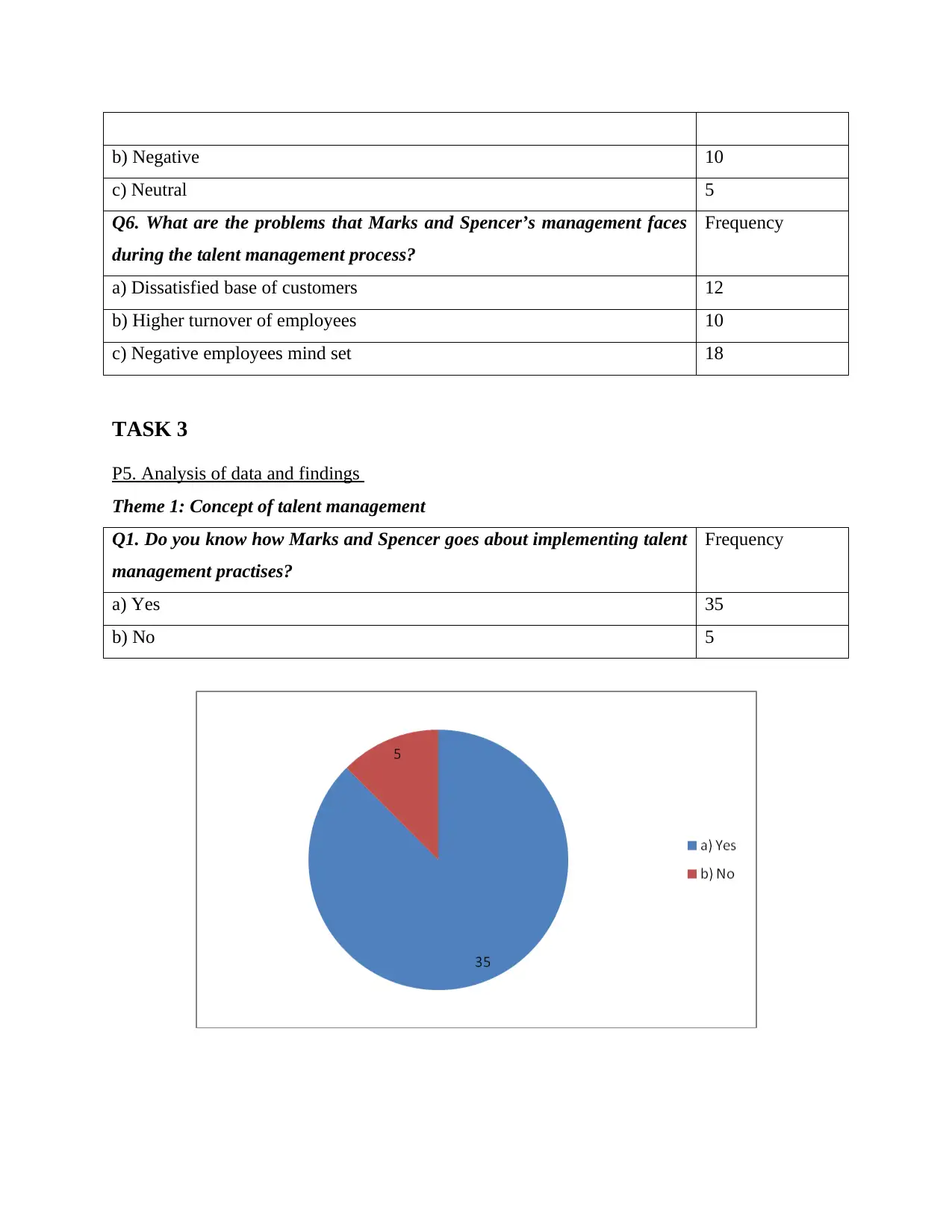
b) Negative 10
c) Neutral 5
Q6. What are the problems that Marks and Spencer’s management faces
during the talent management process?
Frequency
a) Dissatisfied base of customers 12
b) Higher turnover of employees 10
c) Negative employees mind set 18
TASK 3
P5. Analysis of data and findings
Theme 1: Concept of talent management
Q1. Do you know how Marks and Spencer goes about implementing talent
management practises?
Frequency
a) Yes 35
b) No 5
c) Neutral 5
Q6. What are the problems that Marks and Spencer’s management faces
during the talent management process?
Frequency
a) Dissatisfied base of customers 12
b) Higher turnover of employees 10
c) Negative employees mind set 18
TASK 3
P5. Analysis of data and findings
Theme 1: Concept of talent management
Q1. Do you know how Marks and Spencer goes about implementing talent
management practises?
Frequency
a) Yes 35
b) No 5
⊘ This is a preview!⊘
Do you want full access?
Subscribe today to unlock all pages.

Trusted by 1+ million students worldwide
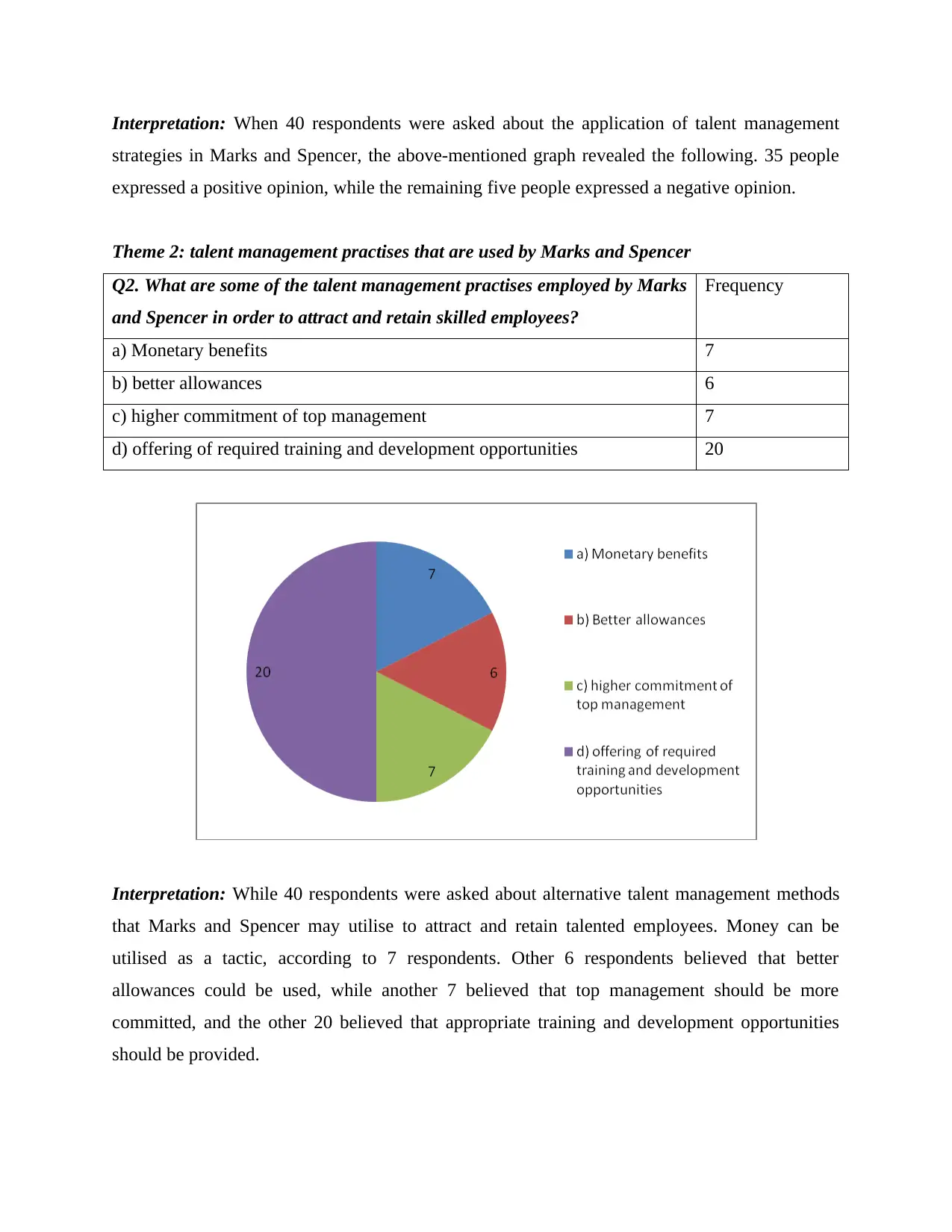
Interpretation: When 40 respondents were asked about the application of talent management
strategies in Marks and Spencer, the above-mentioned graph revealed the following. 35 people
expressed a positive opinion, while the remaining five people expressed a negative opinion.
Theme 2: talent management practises that are used by Marks and Spencer
Q2. What are some of the talent management practises employed by Marks
and Spencer in order to attract and retain skilled employees?
Frequency
a) Monetary benefits 7
b) better allowances 6
c) higher commitment of top management 7
d) offering of required training and development opportunities 20
Interpretation: While 40 respondents were asked about alternative talent management methods
that Marks and Spencer may utilise to attract and retain talented employees. Money can be
utilised as a tactic, according to 7 respondents. Other 6 respondents believed that better
allowances could be used, while another 7 believed that top management should be more
committed, and the other 20 believed that appropriate training and development opportunities
should be provided.
strategies in Marks and Spencer, the above-mentioned graph revealed the following. 35 people
expressed a positive opinion, while the remaining five people expressed a negative opinion.
Theme 2: talent management practises that are used by Marks and Spencer
Q2. What are some of the talent management practises employed by Marks
and Spencer in order to attract and retain skilled employees?
Frequency
a) Monetary benefits 7
b) better allowances 6
c) higher commitment of top management 7
d) offering of required training and development opportunities 20
Interpretation: While 40 respondents were asked about alternative talent management methods
that Marks and Spencer may utilise to attract and retain talented employees. Money can be
utilised as a tactic, according to 7 respondents. Other 6 respondents believed that better
allowances could be used, while another 7 believed that top management should be more
committed, and the other 20 believed that appropriate training and development opportunities
should be provided.
Paraphrase This Document
Need a fresh take? Get an instant paraphrase of this document with our AI Paraphraser
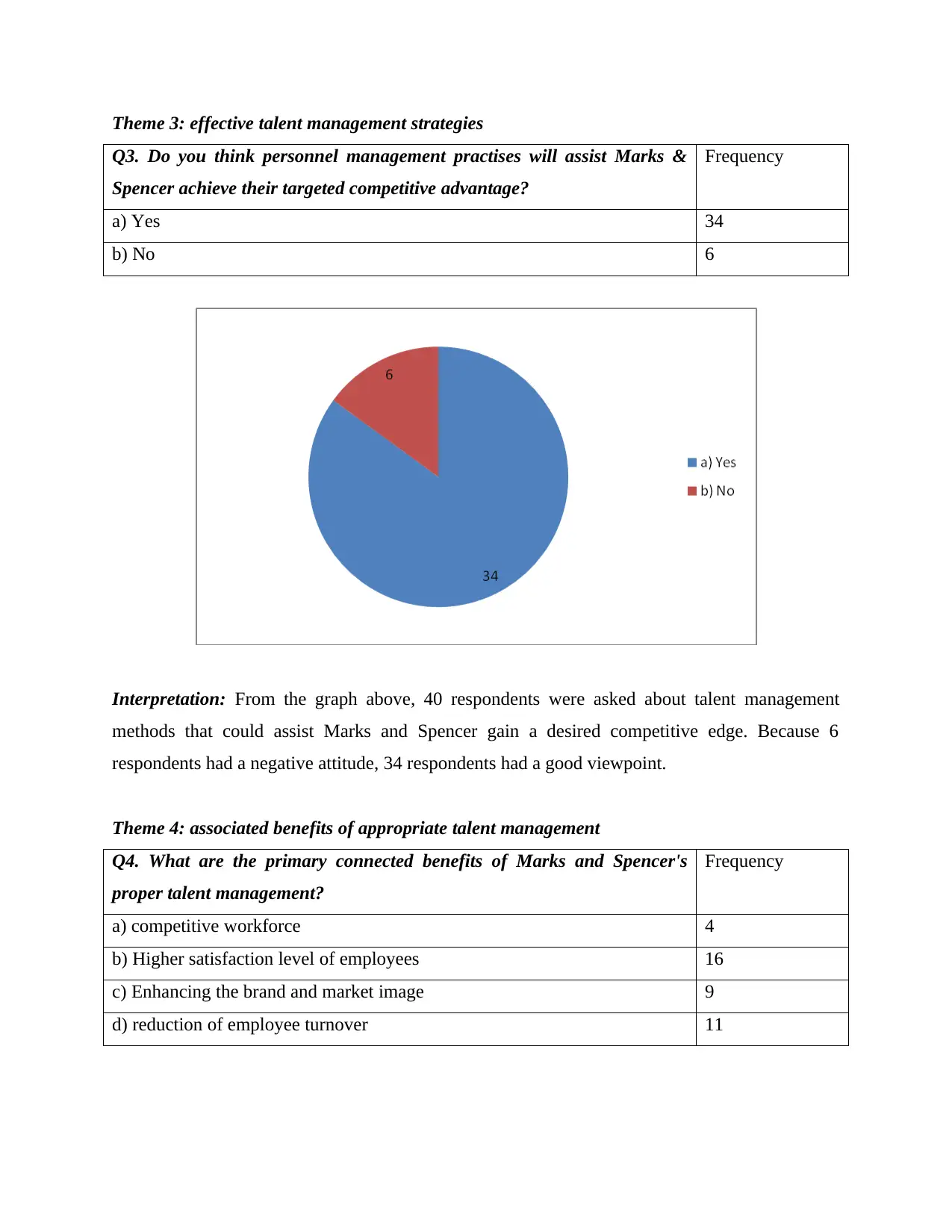
Theme 3: effective talent management strategies
Q3. Do you think personnel management practises will assist Marks &
Spencer achieve their targeted competitive advantage?
Frequency
a) Yes 34
b) No 6
Interpretation: From the graph above, 40 respondents were asked about talent management
methods that could assist Marks and Spencer gain a desired competitive edge. Because 6
respondents had a negative attitude, 34 respondents had a good viewpoint.
Theme 4: associated benefits of appropriate talent management
Q4. What are the primary connected benefits of Marks and Spencer's
proper talent management?
Frequency
a) competitive workforce 4
b) Higher satisfaction level of employees 16
c) Enhancing the brand and market image 9
d) reduction of employee turnover 11
Q3. Do you think personnel management practises will assist Marks &
Spencer achieve their targeted competitive advantage?
Frequency
a) Yes 34
b) No 6
Interpretation: From the graph above, 40 respondents were asked about talent management
methods that could assist Marks and Spencer gain a desired competitive edge. Because 6
respondents had a negative attitude, 34 respondents had a good viewpoint.
Theme 4: associated benefits of appropriate talent management
Q4. What are the primary connected benefits of Marks and Spencer's
proper talent management?
Frequency
a) competitive workforce 4
b) Higher satisfaction level of employees 16
c) Enhancing the brand and market image 9
d) reduction of employee turnover 11
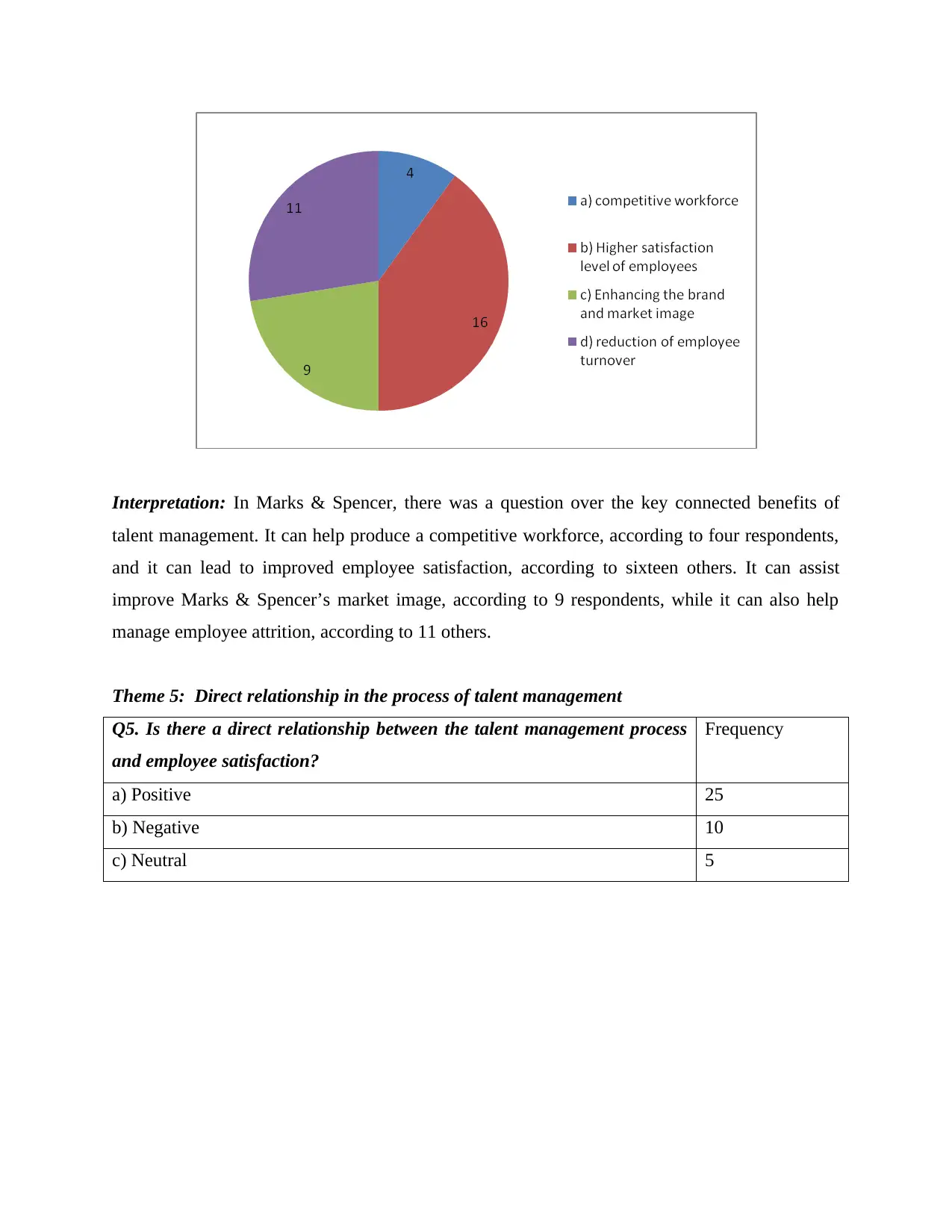
Interpretation: In Marks & Spencer, there was a question over the key connected benefits of
talent management. It can help produce a competitive workforce, according to four respondents,
and it can lead to improved employee satisfaction, according to sixteen others. It can assist
improve Marks & Spencer’s market image, according to 9 respondents, while it can also help
manage employee attrition, according to 11 others.
Theme 5: Direct relationship in the process of talent management
Q5. Is there a direct relationship between the talent management process
and employee satisfaction?
Frequency
a) Positive 25
b) Negative 10
c) Neutral 5
talent management. It can help produce a competitive workforce, according to four respondents,
and it can lead to improved employee satisfaction, according to sixteen others. It can assist
improve Marks & Spencer’s market image, according to 9 respondents, while it can also help
manage employee attrition, according to 11 others.
Theme 5: Direct relationship in the process of talent management
Q5. Is there a direct relationship between the talent management process
and employee satisfaction?
Frequency
a) Positive 25
b) Negative 10
c) Neutral 5
⊘ This is a preview!⊘
Do you want full access?
Subscribe today to unlock all pages.

Trusted by 1+ million students worldwide
1 out of 20
Related Documents
Your All-in-One AI-Powered Toolkit for Academic Success.
+13062052269
info@desklib.com
Available 24*7 on WhatsApp / Email
![[object Object]](/_next/static/media/star-bottom.7253800d.svg)
Unlock your academic potential
Copyright © 2020–2025 A2Z Services. All Rights Reserved. Developed and managed by ZUCOL.





